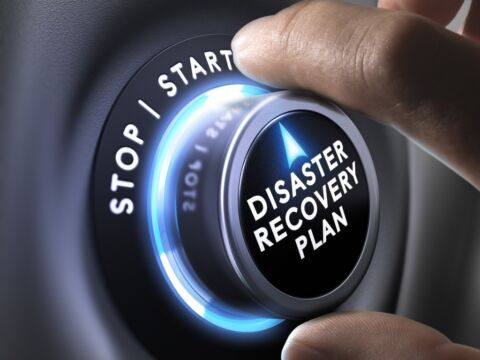Editor’s note: This post was updated on July 13, 2022.
Everyone wants their data to be as secure as possible. If you’re working for a modern organization, chances are data protection is a top priority for your business. As you’re working towards maintaining that goal, there are two types of protection you should consider: traditional data backup and disaster recovery.
Regular data backup’s goal is to ensure certain data is protected and/or retrievable in the case of events like corruption and deletion. Think about data backup as the basic protection layer.

Disaster recovery, on the other hand, is more focused on business continuity. Let’s say there’s a huge water leak on the floor above your office, and it seeps down to where your data systems are. That could result in a disaster with the potential to disrupt your organization from being able to properly function.
So, how do you account for that? How long would it take to get your systems back up? How long would it take you to scramble for new hardware, new peripherals, and so on? Disaster recovery planning is about preparing for and countering scenarios where things happen that bring your business to a halt and cost you valuable—sometimes even business-critical—uptime. Let’s delve a bit deeper!
Should You Invest in Disaster Recovery Planning?
Disaster recovery can largely be thought of as an insurance policy for your organization’s data. Some companies invest a substantial amount of capital resources, time, infrastructure, and processes to ensure that they’re protected. Other organizations calculate the risk, evaluate the probability of disasters occurring where their data is being held, and don’t invest much into their disaster recovery planning. Then there are the organizations that are required to have a certain level of insurance for disaster recovery planning protection due to their industry or certain regulations they must abide by.
The reality of it is that no one can account for mother nature or freak man-made disasters 100% of the time, and things do happen in the world we live in. Disaster recovery has become top of mind enough to where traditional organizations are now investing in multiple data centers across different regions and in the cloud. Speaking of which…

Disaster Recovery and Cloud Services
Before selecting a cloud service provider to work with, it’s essential to understand what they offer in the way of disaster recovery planning. Many of them have built-in planning as part of their offering, but every service is different. It’s on you to find out if a service has plans in place, what those plans are, and to evaluate those plans to ensure that they’re sufficient for what your organization’s needs are, and fill any gaps that might need to be addressed with third-party solutions
Some questions to ask are:
- “What is your uptime?”
- “How many outages have you had over the last couple of years?”
- “How long were those outages?”
As a client entrusting a cloud provider to host your organization’s applications and data inside of its service, that’s definitely part of the agreement you go through in understanding what your commitment is and what the guarantees are to ensure their disaster recovery lines up with your objectives for the most critical applications for your business.
Microsoft, for example, acknowledges that they have various limitations when it comes to protecting their customers’ data. While they continue to keep their infrastructure secure, they cannot account for unforeseen downtimes, outages, and other data loss events. When this happens, the customers will always be responsible for their data, endpoints, accounts, and access management.
The cloud offers plenty of elasticity and can account for many more disasters than on-premises protection; you just have to make sure your most business-critical applications will be safe with whichever cloud service you choose. If you want to create your own disaster recovery plan, however…

What to Consider When Building a Disaster Recovery Plan
To create a successful disaster recovery plan, the first step is to understand your company and what your mission-critical applications are. Ask yourself: What’s your core business? What do you need for daily operations? What’re those core applications that you absolutely must have for your business to run properly?
Most organizations take a tiered analysis approach. They plan around higher tiers (or the core applications) and figure out how they run, what they need to run, and the critical staffing necessary.
“Measure out the importance of everything your organization uses [and] how long you can afford to lose it…”
The next step is to lay out worst-case scenarios. How long can those business-critical applications be down before your business sustains irreparable losses? How long would it take to get them back up and running again? How much planning and how many resources can you allocate towards your disaster recovery plan to meet your objectives of minimizing that potential window?
Then you move on to evaluating the other tiers, such as auxiliary processes or applications that the business utilizes on a daily basis. Measure out the importance of everything your organization uses, how long you can afford to lose it, and any other applicable factors. The key is to be as thorough as possible.

Final Thoughts
Both regular backup and disaster recovery are vital and service two different needs. Traditional backup is important to ensure that your access to data is maintained at all times. Disaster recovery is more so an overarching protection strategy around your business, your brand, and your operations. They’re both vital, and they both help the organization in unique ways.
Again, if you’re on Microsoft 365 and you’re looking for a way to ensure your data is protected and easily retrievable in disaster scenarios—especially the ones you are responsible to protect—you should definitely consider Microsoft Azure Backup solutions that can aid your disaster recovery process.
Backup and disaster recovery go hand in hand to help you be as secure as possible and ready for unforeseen risks. Leverage your cloud providers’ native functionalities and get solutions that can help you attain maximum security in today’s ever-evolving cloud.





